Abstract
The number of tourists travelling to spend their free time elsewhere than in their country of residence has exceeded 1.2 billion, which means that one in six people on the planet travel for tourism purposes. The world economy at the moment undergoes two revolutions, one in the field of IT, and the other in the field of tourism. Tourism is a factor of economic growth; it creates and maintains workplaces, every 11themployee on the planet works in a field from the travel and hospitality industry. Tourism is a factor of social transformation, facilitating an unprecedented closeness between cultures and civilizations in history, people travelling to increasingly remote places compared to their own location, meeting other people, discovering other food, other music, other habits, and instant and always peaceful cultural exchanges take place within this cultural process. In this context, the
Keywords: Universityeducationsustainabilitycrisisgeography
1.Introduction
Tourism development has a number of consequences on the use of human resources in terms of
creating new workplaces, determining a high level of professional training in professional structures and
positions. The specificity of tourism activity, its complexity, given by the variety and the multitude of
components, leave their mark on the staffing needs and its structure, on its requirements in terms of
selection and training, on the efficiency of using the labour force (Mazilu,Mitroi,2010).In their totality,
the labour peculiarities in tourism directly affect the dynamics and the number of workers, the labour
productivity level, their structure, the incentive systems and, consequently, the recruitment and selection
policies, the professional training structure. In tourism, human resources play an important role in
activating the demand, achieving an atmosphere of relaxation, expressing the decision to purchase, to
form and maintain the sympathy, the interest for a specific tourism product or the holiday destination,
hotel or catering unit, the recreation form or the transport means and, respectively, the triggering of
tourist returns (Mazilu, 2012) An objective analysis on the labour market in Romania emphasizes a
generally positive picture compared to previous years, thus the unemployment rate has remained broadly
stable, slightly below 7% and well below the EU average of 9.5%. It is expected to decline even further
by 2017, as a result of strong economic growth.
(http://www.cdep.ro/afaceri_europene/CE/2016/SWD_2016_91_RO_DOCUMENTDETRAVAIL_f.doc)
.
Unfortunately, we must mention the poor access and management of structural funds and
European investments (The ministry reported that, during 2007-2015, 337 projects aiming at the increase
of the quality in education and the initial and continuous vocational education were implemented. The
total value of these projects was of approximately EUR 261.5 million). Also, the tertiary education
graduation rate has increased steadily over the last decade, reaching 25% in 2014 and almost reaching the
national target of 26.7% set forth within the Europe 2020 strategy (Fig.1). The employment rate for
graduates of tertiary education remains a concern, being decreased by more than 7 percentage points in
the past three years, suggesting that universities are insufficiently responsive to the developments on the
labour market. According to
on the prevention and correction of macroeconomic imbalances, conducted by
in February 2016, for the analyzed domain level of Romania - the education -
skills and training in sectors with a high added value, challenges persist regarding the skills offer. The
lack of qualified staff is extremely acute in the healthcare, the construction, the hotel services and the ITC
sectors. There are differences between the types of studies offered. There are plans to better match the
education curricula with the needs of employers, to connect educational databases with the ones from the
labour market and to improve the operation of the centers of assessment and validation of competences”
(WORK DOCUMENT OF COMMISSION SERVICES The Romania Country report for 2016, including
the comprehensive review on the prevention and correction of macroeconomic imbalances, Brussels, 26.02.2016 SWD (2016) European Commission) (Fig.1 and Fig.
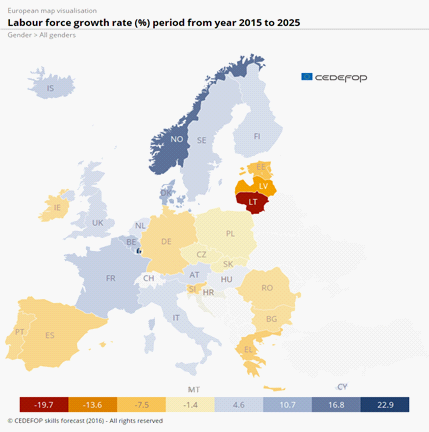
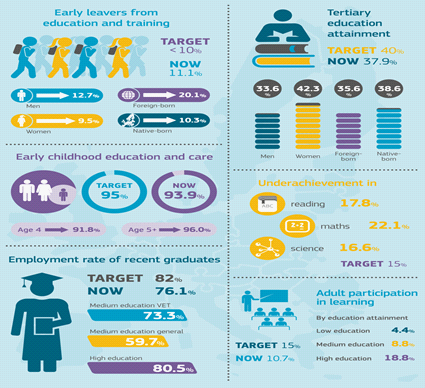
2. Discussion
The share of people in tertiary education in Romania has grown steadily in recent years. The
Romanian government adopted a strategy for tertiary education, which has two general objectives:
increasing the relevance of higher education by better harmonising it with the labour market needs and
improving accessibility to higher education for disadvantaged groups. The tertiary education strategy
adopted in July 2015 (Government decision no. 565 from 15.07.2015) aims to make higher education
more relevant to labour market needs and more accessible to disadvantaged groups. At the same time, a
database integrated in the management systems from 50 public universities has been completed, to allow
the monitoring of the employment of graduates of higher education. The work to harmonise the
occupational standards with the labour market requirements and to update the educational offer has
continued, 36 new standards being developed. It is expected that all universities shall establish guidance
and counselling centres in 2015-2016.The latest policy developments in higher education include:
permission to access non-university programs for pupils who have not passed the baccalaureate
examination; provision by all universities of professional counselling services through a university
counselling centre; the consolidation of mandatory six-month internships in enterprises for all college
graduates. After a longue period we note an expansion of books, academic articles and texts on the
subject of tourism education, ranging from general texts such as Cooper et al. (1994), curriculum studies
such as Lloyd Stear (1981), and reviews of tourism education programs such as Parsons (1991).

There are also currently three important journals in this field: Journal of Hospitality and Tourism
Education, Journal of Teaching in Travel and Tourism, Journal of Hospitality, Leisure, Sport, and
Tourism Education, or Journal of Human Resources in Hospitality and Tourism, Journal of Teaching in
Travel & Tourism. The Tourism Education Futures Initiative: Activating change in tourism education-
(TEFI) is the collective effort of a group of innovative, thoughtful and committed scholars and industry
leaders seeking to provide vision, knowledge, and a framework for tourism education programs that
promote global citizenship and optimism for a better world. Romania complied with the requirement of
having a higher education divided on cycles, according to the BOLOGNA Trial, concluding the transition
period from the old education system imposed by the Law on Education no. 84/1995, republished, to the
current system, and from the point of view of the values set forth for the indicator on the tertiary
education for the 30-34 years age group, its value places us at the lowest values within the EU member
states. Thus, the table no. 1 according to GD 327/2014 on the approval of the total number of student
places for the state pre-university and higher education during the 2014-2015 academic year .
The prognosis analyses determined that Romania could set forth a target of 26.74% for the indicator on
the tertiary education for the 30-34 years age group. The estimated values for the period 2011-2020 are
comprised in table no. 2 and Fig. no. 3 and are achievable by meeting the following conditions:
the progressive increase of the number of student places, by introducing the study grants, set forth for the
Bachelor studies during the period 2013-2016, and by maintaining them until 2020 and
allowing the increase of their relevance under guaranteed quality conditions and a better insertion of the
graduates on the labour market.
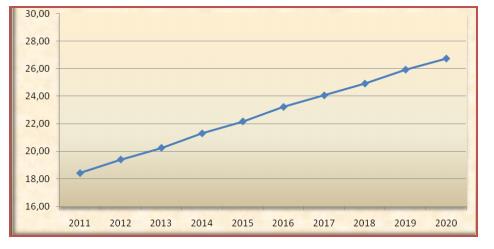
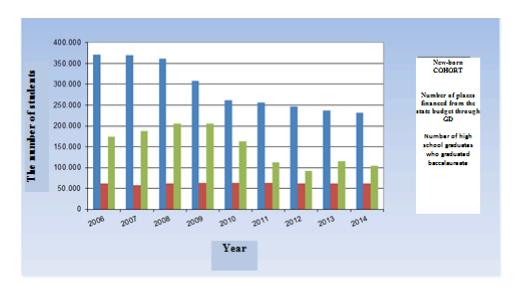
For the 2015-2016 academic year, a number of student places covered by a number of 62.400
study grants for Bachelor studies shall be proposed, being allocated, according to the schooling capacity
compliance requirements, through the order of the Minister of Education and Science(Fig.no4). The study
grants shall be awarded for the entire study cycle. We mention that the proposed total number of student
places for the 2015-2016 academic year shall be classified within the finance approved for the 2015
financial year and shall comply with the budget estimate for the 2015 and 2016 financial years. At the
same time, the compliance with the target undertaken in the Europa 2000 Strategy is considered,
regarding the registration level within the tertiary education system. Figure no. 5 shows the evolution of
the number of students registered for Bachelor studies during the period 2006-2015.For the Master
studies, a number of 35,600 study grants is set forth, according to the provisions of Law no. 288/2004 on
the organisation of the higher education system, as subsequently amended and supplemented, and of Law
no. 1/2011, as subsequently amended and supplemented, in order to ensure at least half of the number of
study grants allocated for the Bachelor studies.
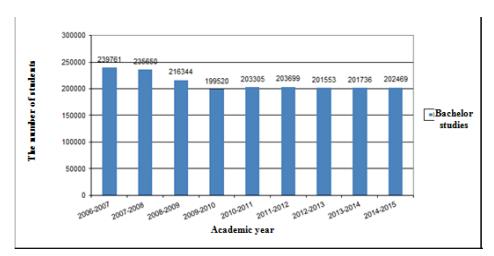
Figure
period 2006-2015.
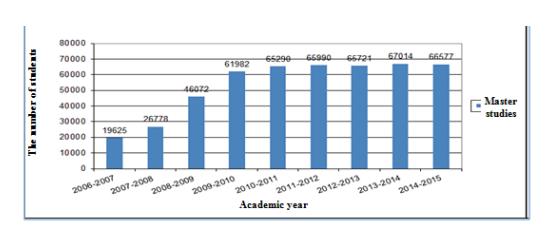
For the Doctoral studies, the proposed number of student places for the 2015-2016 academic year
is of 3,000 study grants. Therefore, we may consider that, through this decision, the Ministry of
Education and Science aims at the increase of the scientific potential of the highly qualified work force in
order to implement the decisions undertaken by Romania through the Lisbon Agenda of transforming the
EU member state societies into knowledge and technological progress societies, which have been
continued through the Partnership Agreement proposed by Romania for the period 2014-2020. The
evolutions of the number of PhD students registered in the day courses and the number of PhD students
registered in the low attendance courses for the period 2006-2015, financed by the state budget, are
shown in figure no. 7. (Mazilu, Gheorgheci, 2016).
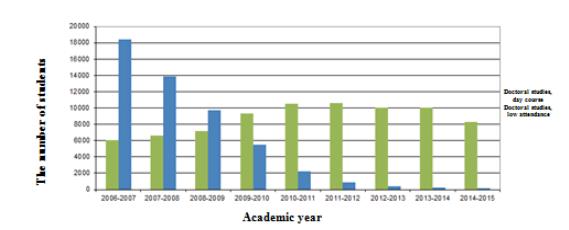
The target segment:
representing at the moment 1/5 from the total number of the tourists, unanimously considered a very
interesting niche, these permanently wanting to experiment more in their travels than spending time in
various clubs, including their percentage at the world level of approximately 20% of the tourists. They
capture our attention and focus on this valuable segment in the context of current tourism. A recent report
drawn up by Skift on this subject, emphasises that these travel now with a purpose and tend to remain
more in the place they visit to improve their linguistic abilities, for authenticity, to make new friends, to
visit historical, archaeological sites, etc. These shall be the future entrepreneurs, the future business
people. The statistics are conclusive: from 15% of the global tourism in the '90s, to 20% in the 2000s, the
travelling students' number is expected to grow to 25% of the global tourism in the near future, changing
the patterns of tourist destinations, the experiments shall take the place of local tourist objectives, the
online information shall rule. A real estimate for this recently shaped market foresees over 300 million
arrivals at the beginning of the 2020s, having a contribution in the market of over USD 320 billion.
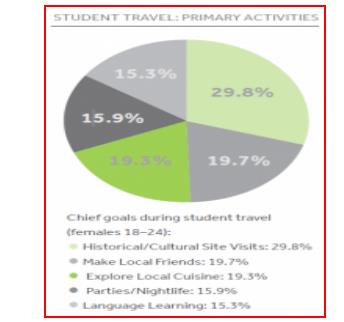
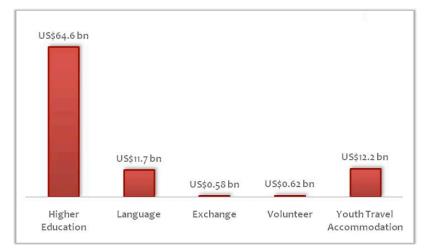
Regarding the presence on the global specialised tourist market, Romania, fortunately, forms part
of the selected countries, having a number of 200-300 educational tour-operating agencies, Serbia filling
a lower place with 50-100 places, while the first place is filled by the following group of countries:
Brazil, France, Germany and China. Among the possible occupations according to the Classification of
Occupations in Romania: the occupations for the Bachelor studies of Tourism Geography are: Risk
manager, Hotel manager, Hostel Manager, Tourism agent, Tour-operator tourism agent, External
transport agent. We have chosen Tourism agent, Pre-university teacher, and Tourism analyst, for the
Bachelor studies. For the Master studies – Tourism and sustainable development, within the University of
Craiova, the occupations shall be: Tour-operator tourism agent, Tourism activity organiser (higher
education), Tourism analyst. Tourism, Science (Fig. 10, Fig. 11).
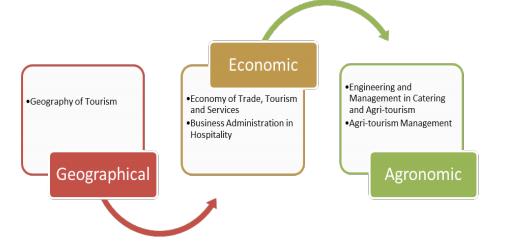
HE tourism studies in Romania appeared in the late 80’, firstly only as simple programs attached
to some economic curriculum (commercial, services), the first tourism related individual bachelor
program was launched in 1991 at Sibiu (Geography of Tourism) by a private university and in 1994
appeared the first public university program at the University of Bucharest (Geography of Tourism) and
others in Suceava, Iaşi, Craiova, Oradea, Cluj, Sibiu, etc. My didactic experience of over 30 years in the
field of geography of tourism and of didactics, as creator of a doctoral school in tourism, I believe that in
the future these aspects and skills that students must learn will outline new analysis issues of the tourism
phenomenon, considered itself as a polyvalent phenomenon, while generating an efficient academic
environment.
Nowadays, there are 89 tourism undergraduate programs in the Romanian universities. 53
economical tourism studies, 22 geographical tourism studies and 20 agronomic tourism studies,
addressing new skills, new values in higher tourism education.
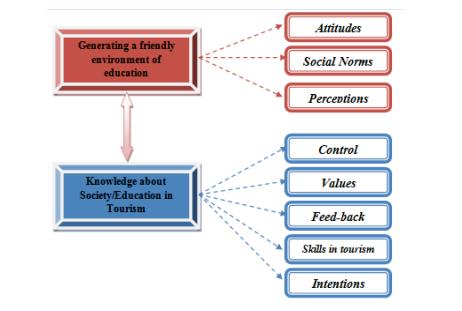
Even if there are a lot of differences between the curricula of the 3 main approaches in HE tourism
studies, we can observe that some topics are covered by all of them: tourism management, tourism
marketing, economy of tourism, tourism statistics, ecotourism/rural tourism/agri-tourism, and economic
geography/geography of resources.
3. Conclusions
The tourist sector of Romania generated 205,000 work places in 2014, number estimated to
increase with 0.6% this year. Regarding the direct contribution of tourism to the work force employment,
this is only 2.3% in Romania (193,000 work places), compared to 5.4% the world average, 13.1% in
Croatia, 5.8% in Hungary, respectively 3.8% in Bulgaria. Unfortunately, tourism education in Romania is
often purely theoretical, most tourism training courses don’t rely on shaping practical skills; while quality
depend on the curricula, syllabi and the qualification of the teaching staff., or the new education must to
provide vision, knowledge and a framework for tourism educations programs, to promote global
citizenship and a better world (Dinu, & Păşcuţ, 2011). Syllabi underlying tourism degree curricula often
comprise a very low amount of practical training classes and these are more often than not poorly
organized. In present, tourism is much more than an economic sector, it is also an educational, social,
cultural, political, and environmental force that drives societal change and the new educators in tourism
play a crucial role in the formation of the younger generation, the future tourism stakeholders and
managers, anyway businessmen with strong knowledge in this beautiful field or area.
References
- Cooper, H., & Hedges, L. B. (Eds.). (1994). Handbook of research synthesis. New York:Russell Sage
- Foundation
- Dinu, M.,& Păşcuţ, A. (2011) Tourism Degrees in Romanian Secondary Education. Recent Researches in
- Tourism and Economic Development, TED,2011,WSEAS PRESS,480.
- Mazilu, M.(2012).The Romanian Tourism - A Promoter of Globalization and Sustainable Development Factor, 470 pag., Published by WSEAS (World Scientific and Engineering Academy and Society) WSEAS Press.
- Mazilu, M., Mitroi, S. (2010). Demographic, social, economic and geographic features – shaping factors of the tourist market. Romanian Economic and Business Review, Vol. 5, No.1, 159-167.
- Mazilu, M., Gheorgheci, S. (2016). Development of a New Geography under the impact of the World crisis in education. Proceedings of BITCO, Publisher College of Tourism, Belgrad, 345-357.
- Parsons, D.(1991). The Making of managers:Lessons from an international review of tourism management education programs. Tourism Management, 12(3), 197-208.
- Stear, L. (1981). Design of a Curriculum for Destination studies. Annals of Tourism Reaearch, vol.8, issue 1,85-95.
- *** WTTC (World Travel and Tourism Council), Economic impact data and forecast, 2015.
- ***The Romania Country report for 2016, including the comprehensive review on the prevention and correction of macroeconomic imbalances, Brussels, 26.02.2016 SWD (2016) European Commission *** Education and Training Monitor 2015 *** Government decision no. 565 from 15.07.2015 http://www.ccsenet.org/journal/index.php/ibr/about/editorialTeamwww.edu.ro http://gov.ro/fisiere/subpagini_fisiere/NF_HG_211-2015.docx http://www.turismmarket.com/wp-content/uploads/2014/10/student-traveler.png http://www.student-market.com/0 http://www.cdep.ro/afaceri_europene/CE/2016/SWD_2016_91_RO_DOCUMENTDETRAVAIL_f.doc http://www.dreptonline.ro/legislatie/hg_327_2014_cifre_scolarizare_invatamant_preuniversitar_superior_stat_anul_scolar_universitar_2014_2015.php http://www.turism.gov.ro/turism/studii---strategii http://www.cedefop.europa.eu/en/publications-and-resources/data-visualisations/labour-force
Copyright information

This work is licensed under a Creative Commons Attribution-NonCommercial-NoDerivatives 4.0 International License.
About this article
Publication Date
25 May 2017
Article Doi
eBook ISBN
978-1-80296-022-8
Publisher
Future Academy
Volume
23
Print ISBN (optional)
-
Edition Number
1st Edition
Pages
1-2032
Subjects
Educational strategies, educational policy, organization of education, management of education, teacher, teacher training
Cite this article as:
Mazilu, M., & Andrei, M. (2017). Need To Change In Tourism Geography At University. In E. Soare, & C. Langa (Eds.), Education Facing Contemporary World Issues, vol 23. European Proceedings of Social and Behavioural Sciences (pp. 423-430). Future Academy. https://doi.org/10.15405/epsbs.2017.05.02.52

